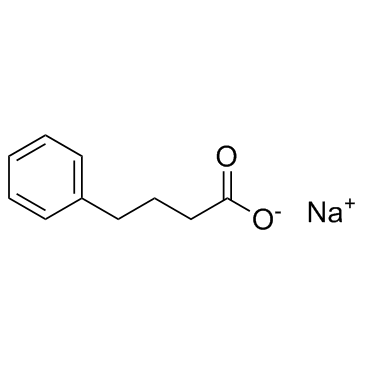Sodium phenylbutyrate

Sodium phenylbutyrate structure
|
Common Name | Sodium phenylbutyrate | ||
|---|---|---|---|---|
| CAS Number | 1716-12-7 | Molecular Weight | 186.183 | |
| Density | 1.095g/cm3 | Boiling Point | 290.7ºC at 760mmHg | |
| Molecular Formula | C10H11NaO2 | Melting Point | 207 °C (dec.)(lit.) | |
| MSDS | Chinese USA | Flash Point | 187.9ºC | |
| Symbol |

GHS07 |
Signal Word | Warning | |
|
The effect of glucose concentration and sodium phenylbutyrate treatment on mitochondrial bioenergetics and ER stress in 3T3-L1 adipocytes.
Biochim. Biophys. Acta 1853(1) , 213-21, (2015) While the 3T3-L1 adipocyte model is routinely used for the study of obesity and diabetes, the mitochondrial respiratory profile in normal versus high glucose has not been examined in detail. We matured adipocytes in normal (5mM) or high (30 mM) glucose and in... |
|
|
Saururus chinensis Baill induces apoptosis through endoplasmic reticulum stress in HepG2 hepatocellular carcinoma cells.
Food Chem. Toxicol. 83 , 183-92, (2015) In this study, we examined the mechanism underlying the effect of Saururus chinensis Baill (saururaceae) on hepatocellular carcinoma HepG2 cells. HepG2 cells and Chang cells were exposed to various concentrations of S. chinensis Baill extract (SC-E) for 24 h.... |
|
|
Phenylbutyrate induces cathelicidin expression via the vitamin D receptor: Linkage to inflammatory and growth factor cytokines pathways.
Mol. Immunol. 63(2) , 530-9, (2015) Antimicrobial peptides (AMPs) constitute an indispensable arm of innate immunity against infectious microbes in humans. Induction of endogenous AMPs may become an alternative therapy against infections. Our previous studies have demonstrated phenylbutyrate (P... |
|
|
Attenuation of ER stress prevents post-infarction-induced cardiac rupture and remodeling by modulating both cardiac apoptosis and fibrosis.
Chem. Biol. Interact. 225 , 90-8, (2015) Endoplasmic reticulum (ER) stress is implicated in the pathophysiology of various cardiovascular diseases, but the role of ER stress in cardiac rupture and/or remodeling after myocardial infarction (MI) is still unclear. Here we investigated whether ER stress... |
|
|
Chemical chaperones reduce ionizing radiation-induced endoplasmic reticulum stress and cell death in IEC-6 cells.
Biochem. Biophys. Res. Commun. 450(2) , 1005-9, (2014) Radiotherapy, which is one of the most effective approaches to the treatment of various cancers, plays an important role in malignant cell eradication in the pelvic area and abdomen. However, it also generates some degree of intestinal injury. Apoptosis in th... |
|
|
Glucotoxic conditions induce endoplasmic reticulum stress to cause caspase 3 mediated lamin B degradation in pancreatic β-cells: protection by nifedipine.
Biochem. Pharmacol. 86(9) , 1338-46, (2013) Nuclear lamins form the lamina on the interior of the nuclear envelope, and are involved in the regulation of various cellular processes, including DNA replication and chromatin organization. Despite this evidence, little is known about potential alterations ... |
|
|
Ocular-specific ER stress reduction rescues glaucoma in murine glucocorticoid-induced glaucoma.
J. Clin. Invest. 124(5) , 1956-65, (2014) Administration of glucocorticoids induces ocular hypertension in some patients. If untreated, these patients can develop a secondary glaucoma that resembles primary open-angle glaucoma (POAG). The underlying pathology of glucocorticoid-induced glaucoma is not... |
|
|
Analysis of pseudoxanthoma elasticum-causing missense mutants of ABCC6 in vivo; pharmacological correction of the mislocalized proteins.
J. Invest. Dermatol. 134(4) , 946-53, (2014) Mutations in the ABCC6 gene cause soft-tissue calcification in pseudoxanthoma elasticum (PXE) and, in some patients, generalized arterial calcification of infancy (GACI). PXE is characterized by late onset and progressive mineralization of elastic fibers in d... |
|
|
Improved liver function and relieved pruritus after 4-phenylbutyrate therapy in a patient with progressive familial intrahepatic cholestasis type 2.
J. Pediatr. 164(5) , 1219-1227.e3, (2014) To examine the effects of 4-phenylbutyrate (4PB) therapy in a patient with progressive familial intrahepatic cholestasis type 2. A homozygous c.3692G>A (p.R1231Q) mutation was identified in ABCB11. In vitro studies showed that this mutation decreased the cell... |
|
|
Chemical corrector treatment ameliorates increased seizure susceptibility in a mouse model of familial epilepsy.
Nat. Med. 21(1) , 19-26, (2015) Epilepsy is one of the most common and intractable brain disorders. Mutations in the human gene LGI1, encoding a neuronal secreted protein, cause autosomal dominant lateral temporal lobe epilepsy (ADLTE). However, the pathogenic mechanisms of LGI1 mutations r... |